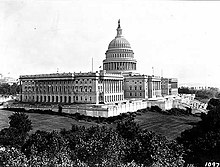54th United States Congress
| 54th United States Congress | |
|---|---|
|
53rd ←
→ 55th
|
|

United States Capitol (1906)
|
|
| March 4, 1895 – March 4, 1897 | |
| Senate President | Adlai E. Stevenson (D) |
| Senate Pres. pro tem: | William P. Frye (R) |
| House Speaker: | Thomas B. Reed (R) |
| Members: | 90 Senators 357 Representatives 4 Non-voting members |
| Senate Majority: | Republican (plurality) |
| House Majority: | Republican |
| Sessions | |
|
1st: December 2, 1895 – June 11, 1896 2nd: December 7, 1896 – March 3, 1897 |
|
The Fifty-fourth United States Congress was a meeting of the legislative branch of the United States federal government, consisting of the United States Senate and the United States House of Representatives. It met in Washington, D.C. from March 4, 1895 to March 4, 1897, during the last two years of Grover Cleveland's presidency. The apportionment of seats in the House of Representatives was based on the Eleventh Census of the United States in 1890. The House had a Republican majority, and the Republicans were the largest party in the Senate.
This count identifies party affiliations at the beginning of the first session of this Congress, and includes members from vacancies and newly admitted states, when they were first seated. Changes resulting from subsequent replacements are shown below in the "Changes in membership" section.
This list is arranged by chamber, then by state. Senators are listed by class, and Representatives are listed by district.
Senators were elected by the state legislatures every two years, with one-third beginning new six-year terms with each Congress. Preceding the names in the list below are Senate class numbers, which indicate the cycle of their election. In this Congress, Class 1 meant their term began in the last Congress, requiring re-election in 1898; Class 2 meant their term began in this Congress, requiring re-election in 1900; and Class 3 meant their term ended in this Congress, requiring re-election in 1896.
The names of members of the House of Representatives are preceded by their district numbers.
Both representatives were elected statewide on a general ticket.
(2 Republicans)
Both representatives were elected statewide on a general ticket.
(2 Republicans)
The count below reflects changes from the beginning of the first session of this Congress.
Two seats were added when Utah was admitted and one seat was filled late.
...
Wikipedia
